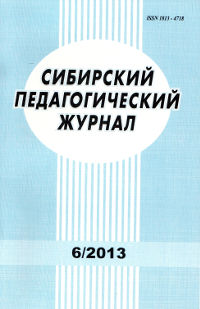Evaluating the formation of the designer way of thinking in students (based on the study in Tomsk universities)
Abakumova, N. N., Protasova, E. K., 2017. Development of diagnostic tools for students in art education. Thesaurus. Institute MVD, 4, pp. 3–10 (In Russ.).
Abakumova, N. N., Yaskevich, I. N., 2017. Monitoring of effectiveness of institutions of art education in the region with a high innovative potential: to statement of the problem. St. Petersburg Education Bulletin, 6–7 (10–11), pp. 51–54. (In Russ.).
Borisanova, D. A., Krasnorjadtseva, O. M., 2016. Actualization of creative potentialities of adolescents and youth in conditions of additional education: network resource. Bulletin of the Novosibirsk State Pedagogical University, 5, pp. 24–33. DOI: http://dx.doi.org/10.15293/2226-3365.1605.02 (In Russ.).
Budakova, A. V., Matsuta, V. V., 2016. Differences in personal potential in highly intelligent students. Novosibirsk State Pedagogical University Bulletin, 6, pp. 17–30. DOI: http://dx.doi.org/10.15293/2226-3365.1606.02 (In Russ.).
Protasova, E. K., 2018. Teaching stylised image as a means to develop abstract imaginative thinking in students. Tomsk State University Journal, 430, pp. 152–158. DOI: 10.17223/15617793/430/21 (In Russ.).
Savinov, A. M., 2013. To the question of the development of the skills to express project ideas using the means of drawing. Art History and Design in the Modern World: traditions and perspectives: materials of the VI All-Russian Scientific and Practical Conference of Young Scientists, pp. 258–263. (In Russ.).
Savinov, A. M., 2014. Evaluating criteria for educational drawings of students-designers. European Social Science Journal, l, 6, pp. 178–181. (In Russ.).
Yaskevich, I. N., 2017. Investigation of the innovative potential of students of an artistic profile: the statement of the problem. Trends in science and education in the modern world, 2–3, pp. 26–27. (In Russ.).
Aflatoony, L., Wakkary, R., Neustaedter, C., 2018. Becoming a design thinker: assessing the learning process of students in a secondary level design thinking course. The International Journal of Art and Design Education, 37, iss. 3, pp. 438–453. DOI: https://doi.org/10.1111/jade.12139
Asefi, M., Imani, E., 2018. Effects of active strategic traching model (ASTM) in creative and critical thinking skills of architecture students. Archnet-Ijar International Journal of Architecture Research, 12, 2, pp. 209–222. DOI: http://dx.doi.org/10.26687/archnet-ijar.v12i2.1340
Bovill, C., Cook-Sather, A., Felten, P., Millard, L., Moore-Cherry, N., 2016. Addressing potential challenges in co-creating learning and teaching: overcoming resistance, navigating institutional norms and ensuring inclusivity in student-staff partnerships. Higher Education, 71, 2, pp. 195–208. DOI: https://doi.org/10.1007/s10734-015-9896-4
Cassim, F., 2013. Hands on, hearts on, minds on: design thinking within an education context. The International Journal of Art and Design Education, 32, 2. Special Issue: Design Education: International Perspectives and Debates, pp. 190–202. DOI: https://doi.org/10.1111/j.1476-8070.2013.01752.x
Chanthala, Ch., Santiboon, T., Ponkham, K., 2018. Instructional designing the STEM education model for fostering creative thinking abilities in physics laboratory environment classes. AIP Conference Proceedings, 1923, 1. DOI: https://doi.org/10.1063/1.5019501
Chia-Ying, H., 2018. Developing Design through a Creative Problem-Solving Process: A Group Community Art Project. International Journal of Art and Design Education, 37, 3, pp. 541–553.DOI: http://dx.doi.org/10.1111/jade.12155
Dietrich, A., Haider, H., 2015. Human creativity, evolutionary algorithms, and predictive representations: The mechanics of thought trials. Psychonomic Bulletin and Review, 22, 4, pp. 897–915. DOI: http://dx.doi.org/10.3758/s13423-014-0743-x
Ghanizadeh, A., 2017. The interplay between reflective thinking, critical thinking, self-monitoring, and academic achievement in higher education. Higher Education, 74, 1, pp. 101–114. DOI: http://dx.doi.org/10.1007/s10734-016-0031-y
Le Masson, P., Weil, B., Hatchuel, A., 2017. Design theory. Methods and organization for innovation. Springer International Publishing, 388 p. DOI: https://doi.org/10.1007/978-3-319-50277-9
Lyon, Ph., Letschka, P., Ainsworth, T., Haq, I., 2018. Drawing pedagogies in higher education: the learning impact of a collaborative cross-disciplinary drawing course. The International Journal of Art and Design Education, 37, 2, pp. 221–232. DOI: https://doi.org/10.1111/jade.12106
Mironova, Е. Е., 2006. Collection of psychological tests. Part II: Manual. Minsk: Women’s Institute ANVILA, 146 p. (In Russ.).
Poon, T. F., Mazlina, Ch. M., 2017. A review: Formation of character creative students by sternberg theory. International Journal of Academic Research in Business and Social, 7, 3, pp. 572–585.
Pringle, A., Sowden, P. T., 2017. The Mode Shifting Index(MSI): A new measure of the creative thinking skill of shifting between associative and analytic thinking. Thinking Skills and Creativity, 23, pp. 17–28. DOI: http://dx.doi.org/10.1016/j.tsc.2016.10.010
Roxburgh, M., Caratti, E., 2018. The Design of Stereotype and the Image. International Journal of Art and Design Education, 37, 3, pp. 454–468. DOI: http://dx.doi.org/10.1111/jade.12140
Silvia, P. J., 2015. Intelligence and Creativity Are Pretty Similar After All. Educational Psychology Review, 27, 4, pp. 599–606. DOI: http://dx.doi.org/10.1007/s10648-015-9299-1
Stansberry, S. L., 2017. Authentic teaching with technology through situated learning. Journal of Formative Design in Learning, 1, 1, pp. 16–30. DOI: https://doi.org/10.1007/s41686-017-0004-2
Taleyarkan, M., Dasgupta, C., Garcia, J., Magana, A., 2018. Investigating the impact of using a CAD simulation tool on students’ learning of design thinking. Journal of science education and technology, 27, pp. 334–347. DOI: http://dx.doi.org/10.1007/s10956-018-9727-3
Torrance, E. P., 1962. Guiding creative talent. Englewood Cliffs, N. J.: Prentice-Hall, 278 p.
Torrance, E. P., 1965. Rewarding Creative Behavior. Experiments in Classroom Creativity. Englewood Cliffs, N. J.: Prentice-Hall, 353 p.
Ustyuzhanina, A., Plotnikova, I., Efremova, O., 2017. Business games in Quality control for students of technical universities. Proceedings of 2017 IEEE Global Engineering Education Conference, pp. 44–47. DOI: http://dx.doi.org/10.1109/EDUCON.2017.7942822
Whiley, D., Witt, B., Colvin, R. M., 2017. Enhancing critical thinking skills in first year environmental management students: a tale of curriculum design, application and reflection. Journal of Geography in Higher Education, 41, 2, pp. 166–181. DOI: http://dx.doi.org/10.1080/03098265.2017.1290590
Yanushchik, O. V., Batbold, M., Ustyuzhanina, A. K., 2015. Improving the Organization of the Learning Process in Mathematics for International Students of Technical Universities. Procedia – social and behavioral sciences. International Education and Cross-Cultural Communication, Problems and Solutions (IECC 2015), 215, pp. 202–206. DOI: http://dx.doi.org/10.1016/j.sbspro.2015.11.621




